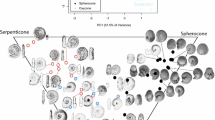Abstract
A previous analysis (Heath 1985; Biol J Linn Soc 24: 165–174) tested and rejected the null hypothesis that gastropods construct their shells with optimal efficiency. The ratio volume of material used to volume of space enclosed (V shell:V space) was used as a measure of inefficiency of construction and shown to exhibit smooth parabolic curves if plotted as a function of whorl overlap. In the present analysis, in contrast, it is demonstrated that inefficiency of a particular combination of mode and rate of shell construction, consisting of variable interapertural areas and rapidly expanding whorl cross sections, is described by polynomial curves with inflection points. As an empirical test of this theoretically derived observation, V shell:V space of shells of four species of marine gastropods [Architectonica perspectiva (L., 1758), Cittarium pica (L., 1758), Euspira heros (Say, 1822), and Telescopium telescopium (L., 1758)] was calculated, using a mathematical model. By varying the vertical component of aperture trajectories [i.e. translation (T )] in the mathematical model, hypothetical forms representing a range of possible whorl overlap were simulated graphically and, for each form, V shell:V space was calculated. Plots of V shell:V space as a function of whorl overlap were described accurately by polynomial curves with inflection points, and each real shell yielded a nonoptimal V shell:V space, exhibiting approximately 75% less whorl overlap than its most efficiently constructed, hypothetical form. Inflection points of inefficiency curves represent critical points at which the reduction of space provided begins to exceed significantly the amount of material saved with increasing whorl overlap, and nonoptimal shell forms might represent compromises between efficient construction and function.
Similar content being viewed by others
Author information
Authors and Affiliations
Additional information
Received: 26 June 1998 / Accepted: 17 March 1999
Rights and permissions
About this article
Cite this article
Stone, J. Using a mathematical model to test the null hypothesis of optimal shell construction by four marine gastropods. Marine Biology 134, 397–403 (1999). https://doi.org/10.1007/s002270050556
Issue Date:
DOI: https://doi.org/10.1007/s002270050556




